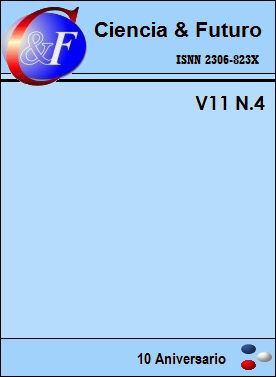Temperaturas generadas en una soldadura por fricción radial disímil mediante elementos finitos
Palabras clave:
elementos finitos, temperatura, flujo de calor, fricción radial.Resumen
Se establecieron las temperaturas que se generan en la soldadura por fricción en barras de acero AISI 316L y el cobre Cu-DHP por medio del método de los elementos finitos (MEF). La simulación se realiza a partir de barras de 12 mm de diámetro y 100 mm de longitud, donde se considera que rota el primero a 1 200 r/m y se le aplica presión de 30 MPa. El mallado se estructuró con 1 358 nodos y 473 mallas. Se determinó que, la máxima temperatura se obtiene a 1 059 oC en la barra de cobre con variación en la interfase entre 945,61 oC y 831,41 oC y que durante el flujo de calor existe un descenso en la línea central de la soldadura.Descargas
Citas
ALAVALA, C. 2016. Weldability of Friction Welding Process for AA2024 Alloy and SS304 Stainless Steel using Finite Element Analysis. Int. Journal of Engineering Research and Application 6(3): 53-57.
AMBROZIAK, A.; WINNICKI, M.; LASKA, P. & LACHOWICZ, M.; ZWIERZCHOWSKI, M.; LESNIEWSKI, J. 2011. Examination of friction coefficient in friction welding process of tubular steel elements. Archives of metallurgy and materials 56(4): 975-980.
ARUN, P.; NITHIN, R.; YADHU, V. & SANALKUMAR, C. 2017. To design and construct a friction welding attachment on lathe, conduct experiment and to study about mechanical behavior of friction welded joints of aluminum rods. International Journal of Engineering Research & Technology (IJERT) 6(07): 150-158.
BUFFA, G.; FRATINI, L.; PASTA, S. & SHIVPURI, R. 2008. On the thermo-mechanical loads and the resultant residual stresses in friction stir processing operations. CIRP Annals - Manufacturing Technology 57(1): 287-290.
KIMURA, M.; INOUE, H.; KUSAKA, M.; KAIZU, K. & FUJI, A. 2010. Analysis method of friction torque and weld interface temperature during friction process of steel friction welding. J. Solid Mech. Mater. Eng 4(3): 401-413.
MISHRA, R.; DE, P. S. & KUMAR, N. 2014. Friction stir processing. In Friction Stir Welding and Processing. Springer International Publishing. pp. 259-296.
MOARREFZADEH, A. 2012. Study of heat affected zone (HAZ) in friction welding process. Journal of Mechanical Engineering 1(1): 11-18.
MUMIN, S. 2016. Optimizing the parameters for friction welding stainless steel to copper Parts. Materiali in tehnologije / Materials and technology 50(1): 109-115.
PEEL, M.; STEUWER, A. & WITHERS, P. 2006. Dissimilar friction stir welds in AA5083-AA6082. Part I: process parameter effects on thermal history and weld properties. Metallurgical and Materials Transactions A 37(7): 2183-2193.
REN, S.; MA, Z. & CHEN, L. 2007. Effect of welding parameters on tensile properties and fracture behavior of friction stir welded Al–Mg–Si alloy. Scripta Materialia 56(6): 69-72.
SESHAGIRIRAO, B.; SIVARAMAKRISHNA, V. & SAIKRISHNAPRASAD, G. 2015. Experimental investigation of rotary friction welding parameters of aluminum (H-30) and mild steel (AISI-1040). International Journal of Innovative Research in Science, Engineering and Technology 4(5): 2920-2925.
SCHMICKER, D.; PERSSON, P. & STRACKELJAN, J. 2014. Implicit geometry meshing for the simulation of rotary friction welding. Journal of Computational Physics 270(115): 478-489.
SUTTON, M.; REYNOLDS, P.; WANG, D. & HUBBARD, C. 2002. Study of residual stresses and microstructure in 2024-T3 aluminum friction stir butt welds. Journal of Engineering Materials and Technology 124(2): 215.
Publicado
Cómo citar
Número
Sección
Esta obra está bajo una Licencia Creative Commons Reconocimiento-NoComercial 4.0 Internacional
La Revista Ciencia & Futuro es una revista de acceso abierto, todo el contenido está disponible gratuitamente sin cargo para el usuario o su institución. Los usuarios pueden leer, descargar, copiar, distribuir, imprimir, buscar o vincular los textos completos de los artículos, o utilizarlos para cualquier otro fin lícito, sin pedir permiso previo al editor o al autor. Todo lo anterior, de acuerdo con la definición de BOAI de acceso abierto.
Los autores que publican en esta revista están de acuerdo con los siguientes términos: Licencia Creative Commons Atribución-NoComercial permite que el beneficiario de la licencia tenga el derecho de copiar, distribuir, exhibir y representar la obra y hacer obras derivadas para fines no comerciales siempre y cuando reconozca y cite la obra de la forma especificada por el autor o el licenciante. Los autores pueden establecer por separado acuerdos adicionales para la distribución no exclusiva de la versión de la obra publicada en la revista (por ejemplo, situarlo en un repositorio institucional o publicarlo en un libro), con un reconocimiento de su publicación inicial en esta revista. Se permite y se anima a los autores a difundir sus trabajos electrónicamente (por ejemplo, en repositorios institucionales o en su propio sitio web) antes y durante el proceso de envío, ya que puede dar lugar a intercambios productivos, así como a una citación más temprana y mayor de los trabajos publicados (Véase The Effect of Open Access) (en inglés). Lo anterior debe realizarse siempre sobre el artículo ya publicado por Ciencia & Futuro.
Los autores mantienen el control sobre la integridad de sus trabajos y el derecho a ser adecuadamente reconocidos y citados.
A los editores se les otorgan derechos no exclusivos para publicar y distribuir.






